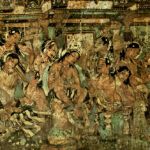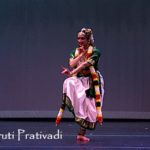Introduction & Book Summary
Bharatanatyam artist Prakruti Prativadi recently published a book ‘Rasas in Bharatanatyam’. ICP’s daughter portal shared an interesting introductory article written by the author. I got a copy of the book from Amazon.com a couple of weeks ago and ended up reading it multiple times. The work is an outcome of several years of research and a first-person experience of living the tradition. The book is intended to be the first of a series.
The author states that the book is aimed at the serious Bharatanatyam artist and connoisseur, and is also beneficial to those who want to learn more about Indic art traditions. An in-depth discussion of the different elements of Bharatanatyam including Abhinaya, Rasa, and Bhava is provided. The book also presents a brief and well-researched history of Bharatanatyam and related traditions in Hinduism, a topic which has endured much distortion and confusion in recent years. The author goes deep into the ancient roots of natya, and succinctly explains the concepts relying on primary sources in Sanskrit and Indic languages. The clarity and authority required to write in a crisp question-answer format, the shraddha, the attention to technical detail, and the reinforcement of key learning points give the book a stamp of authenticity that perhaps only a dedicated practitioner and teacher can produce.
Where to Buy
Readers can set up a discount code ($8.00 off) which is available only from the Createspace page (not the amazon.com page) by following these steps:
- Go to the book’s Createspace page:
- Add the Book to the Cart, this will take buyers to the checkout page
- Add this discount code: PYTKY7GV in the ‘Discount Code’ field and click ‘Apply Discount’ to get a discount, the price of the book will be $28.99.
Please note: Users will have to sign up for a Createspace account (if they don’t have one). Createspace is owned by Amazon.
Bharatanatyam: Embodied Learning & Direct Experience
Poet, Indic scholar, and computer scientist Prof. Subhash Kak has said that the best way to understand India is through its art [2], and the book reaffirms this point. Why art? India is the land of Vedas, so can’t one read Vedic text?
The author discusses the worldview underlying Bharatanatyam and notes that direct experience is central to Hinduism. Through sadhana and shraddha, potentially anyone can transcend their ordinary level of consciousness [1]. This is an amazing and powerful discovery by India’s ancient seers. The armchair-acharya (like the theoretical martial artist and air guitarist) tries to convince us otherwise, but Hinduism recognizes that textual knowledge is useful but it cannot fully delineate the scope of Dharma and Vedas, and we provide two independent explanations regarding this.
Prof. Kak quotes Yaaska [3], the author of the ancient Sanskrit treatise Nirukta: “One who reads the Veda but does not know its meaning is like a draught animal”, and explains that “the idea of knowing the Veda is not merely to read it, but to understand its meaning in one’s heart. This is paradoxical, since one cannot understand the text unless one has already had the experience of its deepest intuitions. The text of the Veda cannot in itself be used for instruction”. We have Bharata Muni’s Natya Sastra, revered as the fifth Veda, that has the wisdom of the four Vedas embedded within, which is available to all people, cutting through all barriers of social and economic status, gender, race, and geography.
In his book Indra’s Net [4], Rajiv Malhotra poses a related question: “How did the rishis ‘see’ the shruti in the first place? Unlike the Abrahamic religions, in which prophets hear from an external God, in the Vedas there is no external voice. There is no entity equivalent to Yahweh who speaks the Vedas to the rishis… Vedas are a-purusheya, i.e., beginningless and authorless. They existed before the rishis ‘saw’ them… Hinduism does not regard the rishis as inherently different in substance or essence from the rest of us…. each human has the same potential as the rishis, and that this potential is realized through disciplined sadhana (the inner sciences of adhyatma-vidya)”. In the Indian context, Rajiv Malhotra coined the term ‘embodied knowing’ to refer to adhyatma vidya, and Indic art forms that employ this inner science surely occupy a pride of place in India’s grand narrative [6]. The deepest authentic ‘ideas of India’ are embedded in Bharatanatyam. We owe a debt of gratitude to dedicated artists who tirelessly practice, promote, and preserve India’s sacred art forms.
Bharatanatyam as Yajna
The book has a brief but insightful discussion of Bharatanatyam as Yajna, which has been explained as a sacred process that establishes links (bandhus) between the inner and the outer world [6]. The material world is not considered separate and discarded but is harmoniously united with the spiritual within Bharatanatyam. Indic art forms are rooted in this Vedic view where consciousness is the basis of ultimate reality itself [3]. Such a Bharatanatyam is unacceptable to the enticing “sweet-speech” Charvaka School [5] that totally rejects Yajna, Puja, Bandhus, and the transcendental domain since they believe that consciousness emerges from neural matter [2]. Bharatanatyam is also incompatible with the irreconcilable duality of history-centric Abrahamic dogma that accepts the transcendental and the transactional domains but keeps their existence independent and infinitely apart [6].
Actively participating in Yajna leads to an internal transformation that is like undergoing a ‘rebirth’ [2]. This leads us to a second, and equally remarkable observation that any sensitive and attuned viewer (Sahridaya) immersed in a Bharatanatyam performance [1] can also potentially attain a higher state of consciousness and transcendental bliss, and this communication is possible due to Rasa. The book explains this process in-depth.
Rasa Ganita
Dharmic thought employs a finite and limited number of levels to manage quantities/qualities that may appear to be unlimited or huge in number, or even indivisible or continuous. How does it work?
On Rasa, Prof. Kak remarks [3]: “An aesthetic attitude is a combination, in varying measures, of the different essences (rasas) of it. It is one of the great insights of the Indian tradition that these essences are supposed to be discrete, and perhaps this idea emerged from the Vaisesika atomic doctrine as well as the idea of Nyaya that mind operates sequentially”. Like Panini and his rules of grammar, Bharata, using only a finite number of sutras, covered the profound topics of Rasa and Bhava and spanned the virtually unlimited expanse of dance and drama.
Paanini has been credited for a grand unified theory of language, and Bharata too can be credited for a similar theory of aesthetics thousands of years ago. The author notes how a danseuse can skillfully conjugate various dance elements such as movements, gestures, etc. mentioned in the Natya Sastra to generate innumerable permutations and combinations to artistically express the myriad emotions and situations that has occurred, or will occur in the future, and convey that meaning to the audience. Bharatanatyam does not limit but encourages unselfish self-expression.
Rasa Awakening in the Audience
In her book, Prakruti ji takes us on a fascinating journey through the Rasa awakening process in Bharatanatyam. The idea of Rasa is ancient and present in the Upanishads [1]. According to the author “Rasa is the supreme aesthetic experience and absolute aesthetic relish that the audience feels when witnessing an artistic performance… Rasa is a heightened state of consciousness and bliss… This experience is called Rasasvada, which is akin to Brahmasvada, a supreme knowledge… Rasa is a Sanskrit word that no equivalent word in English”. A simplified arrow-diagram view of the Rasa awakening sequence/combination given in the book can be described as follows (the interested reader should refer to the book to obtain a complete and correct picture).
Vibhava (cause/determinant): → Anubhavas (consequent reaction) → Vyabhichari Bhavas (temporary emotional states) → Sthayi Bhava (permanent emotional state) → Rasa
(Author dancing selected Paasurams from the Vaarinam Aayiram)
In Bharatanatyam, for example, the process can be triggered by witnessing the Abhinaya of the skillful artist, and given the right conditions, culminate in a heightened state of consciousness within a receptive audience. In an interview, Dr. Ramachandran Nagaswamy confirms this important point about Rasa while correcting the mistaken conclusion of a western Indologist.
Another crucial point made by the author is that the generation of Rasa in a performance is not guaranteed and it requires the harmonious integration of multiple inter-connected factors. The author likens it to a complex and rich recipe. Rasa is not awakened by sensory stimuli such as personal sadness experienced in mundane life, or by artists using the stage to make purely political and social statements. And even if the performance is of the highest caliber, it still requires an attuned viewer (Sahridaya) [1] within whom the ‘aesthetic vibes’ of the performance can resonate. The author quotes Bharata “without Rasa, there can be no meaningful communication”.
Engineering Design Example
Natya Sastra ideas can find applications in diverse fields, including entertainment, advertising, public-service messaging, etc. Given its integral view, teaching Natya Sastra concepts authentically in schools and colleges will benefit not only young artists, but also engineers and scientists. As an analogy and example, modern highway design relies on the PIEV theory of driver response to visual stimuli:
Cause/determinant: → Perception → Intellection → Emotion → Volition
PIEV is used to measure the perception-reaction time of a driver. Triggered by observing an event, the driver first perceives (something happened), grasps the implications (danger to self/others), and this triggers one or more emotions (what to do?), before converging on a final, stable action (brake, steer, or accelerate). PIEV duration differs for a distracted versus fully conscious driver. When deciding where and how to install and calibrate a traffic light, one has to evaluate the combination of all inter-related factors – PIEV, visibility, topography, traffic conditions, etc., in order to maximize the percentage of drivers that will have sufficient time to go through PIEV and make the right decision. PIEV and Rasa may be two different things (although when in danger, even the most materialistic passenger and driver will invoke the divine transcendent charioteer to ensure fast PIEV so they can remain in their transactional world); however, there appear to be similarities – the importance of an integral perspective, a scientific approach, and understanding the roles of emotional states, cognition, and consciousness.
Bharatanatyam & Artificial Intelligence
Today, Artificial Intelligence (AI) systems can generate cooking recipes, write mournful poetry, and has even started writing musical scores. Can machine-generated artistic performances evoke Rasa? Can it replicate the transcendental leap [3] that is possible through a Yajna? These are interesting questions to be answered by experts. Machines are not conscious because they cannot have Bandhus [3], and their art output appears to be generated by algorithms using preset rules distilled from prior art, which were created by highly skilled human artists, not machines. The book has clearly established that the Rasa awakening process and the dance elements of Bharatanatyam are not mechanical.
While machine art may match humans and eventually do better in terms of purely materialist aesthetics, the sacred Indic art-as-Yajna rooted in an integral unity via bandhus that bind the inner and outer worlds, will not only survive, but thrive and give humanity a sense of hope and a glimpse of divinity. This makes it all the more important that Bharatanatyam and classic Indian art be preserved and taught in their authentic form and context. Prakruti Prativadi’s book is a welcome step in this direction.
(This post was written by an aesthetically-challenged Ganita professional ‘armed’ with two right feet, and is an informal exploration of ideas inspired by Prakruti Prativadi’s book).
References
- Rasas in Bharatanatyam. Prakruti Prativadi. CreativeSpace. 2017.
- Art and Cosmology in India. Subhash Kak. Patanjali Lecture, University of Massachusetts, Dartmouth. 2006.
- The Pragna Sutra: Aphorisms of Intuition. Subhash Kak. 2006.
- Indra’s Net: Defending Hinduism’s Philosophical Unity. Rajiv Malhotra. Harper Collins, 2014.
- Epistemology and Language in Indian Astronomy and Mathematics. Roddam Narasimha. Journal of Indian Philosophy. 2007.
- Being Different: An Indian Challenge to Western Universalism. Rajiv Malhotra. Harper Collins, 2011.




Thank you Shivoham-ji, for your kind interest in my book and for writing this wonderfully lucid article. Appreciate your skillful analysis and exploration of how Rasa ties seamlessly, and without contradiction, to other ancient and core Indic concepts. As you’ve so fittingly emphasized, Rasa and Bharatanatyam cannot be comprehended by aloof academic speculation. The AI-Rasa hypothetical situation posed by you is fascinating! And the answer to it, not unsurprisingly, is in the Natyashastra. A very thought-provoking and astute post.
Glad you liked it Prakruti ji. All ideas were inspired by your book. Thank you for writing it, and looking forward to more!